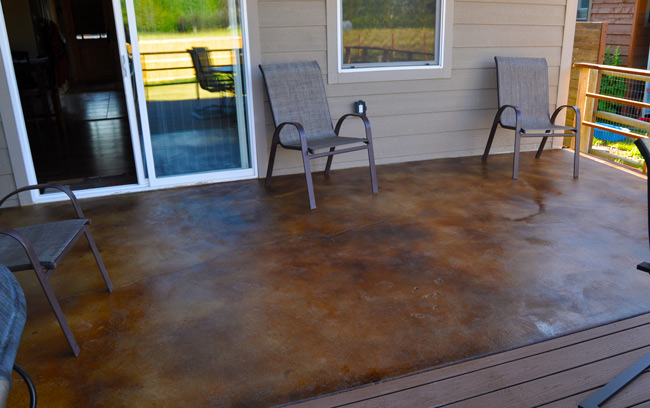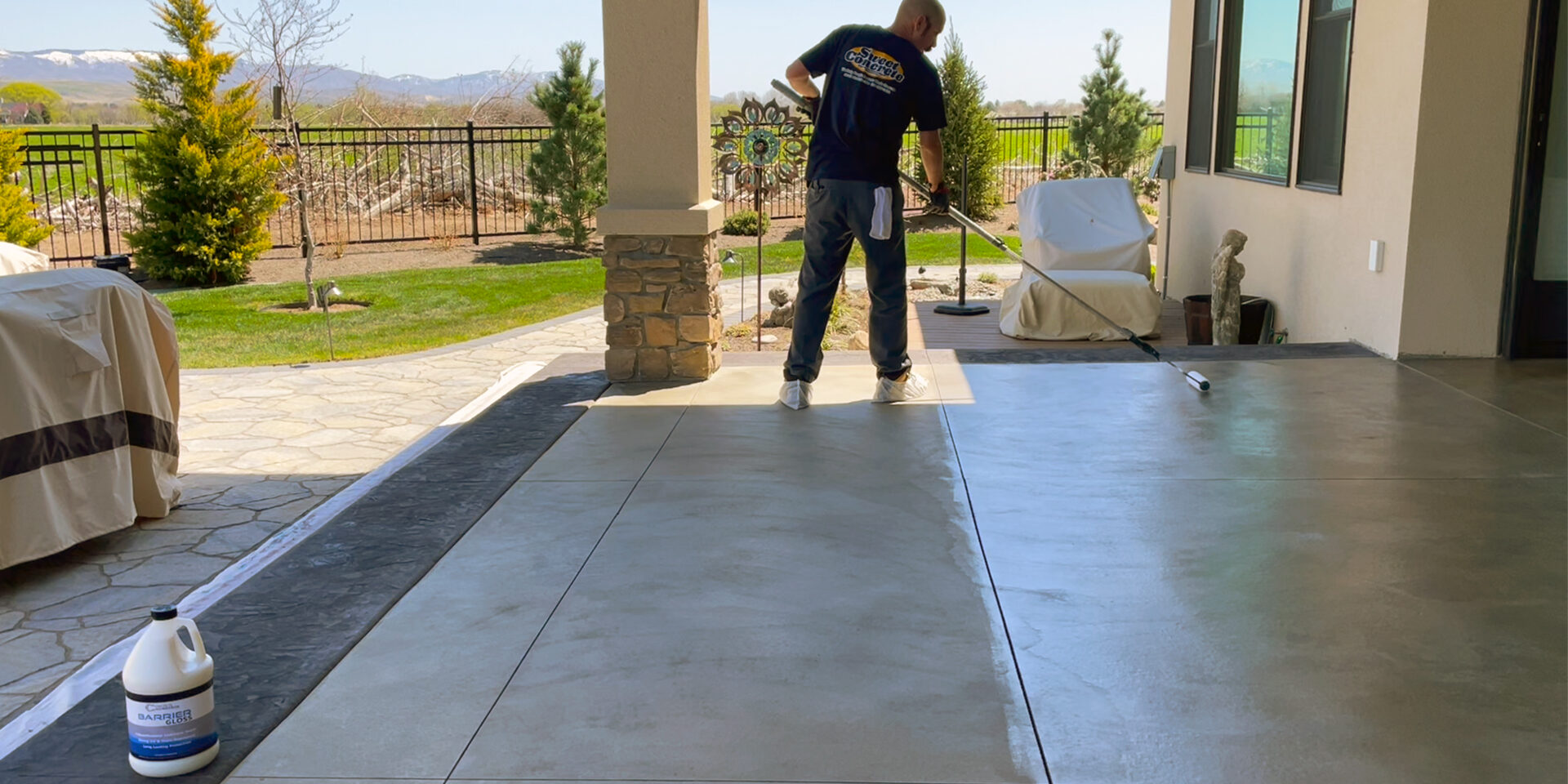Recognizing the Different Kinds of Stained Concrete for Your Following Project
Stained concrete deals different choices that accommodate various aesthetic and practical needs. Each kind presents distinct characteristics that affect the last appearance and resilience of the surface area. Understanding these distinctions is crucial for anyone preparing a task. From rich, chain reactions of acid-based stains to the vibrant harmony of solid color stains, the selections can considerably influence the outcome. What variables should one consider when picking the suitable stain for their certain requirements?
Overview of Stained Concrete
Stained concrete works as a flexible flooring alternative that can enhance the aesthetic allure of numerous areas. This strategy includes applying a tinting representative to the surface of existing concrete, permitting a wide range of layout possibilities. Stained concrete is preferred in both domestic and industrial settings, offering a resilient and low-maintenance option that can resemble the look of natural materials like stone or ceramic tile.
The staining procedure can be carried out making use of water-based or solvent-based products, each offering distinct visual impacts. The last look is affected by aspects such as the initial concrete surface area, the sort of tarnish made use of, and the application approach. Stained concrete not just improves exterior and interiors but also promotes sustainability by revitalizing existing concrete frameworks. Therefore, it has gotten grip amongst home owners and developers seeking both performance and design in their flooring selections.
Acid-Based Stains: Characteristics and Benefits

One-of-a-kind Color Variations
Concrete surfaces can transform dramatically with the application of acid-based stains, which provide a rich combination of special shade variants. These stains pass through the concrete, reacting chemically to produce dynamic earth tones that range from deep browns and reds to soft eco-friendlies and blues. The resulting colors are usually variegated, developing a natural, marble-like appearance that enhances the concrete's character. Each application yields distinct results due to variants in the concrete's structure and the discoloration method utilized, making every job special. Furthermore, acid-based stains can be layered or incorporated with various other methods to produce customized designs, permitting individual expression. This convenience makes acid-based stains a popular selection for both household and business applications.
Chain Reaction Described
While numerous elements contribute to the effectiveness of acid-based stains, the underlying chemical responses play an important role in their one-of-a-kind features and advantages. These stains mainly contain water, acid, and metallic salts. When put on concrete, the acid reacts with the calcium hydroxide in the cement, developing a chemical improvement that results in irreversible shade modifications. The metallic salts pass through the surface and bond with the concrete, enabling a large range of shades and tones. This reaction not just improves aesthetic allure however also supplies sturdiness, making the color immune to fading and wear. Furthermore, acid-based stains can create a variegated surface that mimics all-natural stone, further boosting their popularity for attractive concrete applications.
Surface Prep Work Significance
Achieving suitable results with acid-based stains depends upon thorough surface area prep work. This vital action assurances that the concrete surface area is clean, cost-free of contaminants, and appropriately profiled for perfect discolor absorption. Any existing sealers, dust, or oils can hinder the chain reaction that produces the preferred shade and coating, resulting in unequal or uneven results.
Prior to using the stain, the concrete must be mechanically cleansed or pressure cleaned, adhered to by an extensive inspection for cracks or blemishes that may need repair. In addition, validating the surface area is effectively dried will certainly enhance discolor adherence. By focusing on these preparatory steps, the longevity and vibrancy of acid-based stains can be substantially enhanced, resulting in an extra cosmetically pleasing and durable surface.
Water-Based Stains: Attributes and Benefits

Water-based stains penetrate the concrete, providing an extra translucent surface that highlights the natural structure and variants of the surface below. They are readily available in a wide range of shades, permitting innovative flexibility in design. Additionally, water-based stains are much easier to cleanse up, requiring only water and soap, which simplifies the application process.
Their fast drying out time enhances efficiency, making them a functional selection for both do it yourself enthusiasts and experts. On the whole, water-based stains provide an attractive mix of visual versatility and user-friendly buildings, making them a popular choice for concrete improvement jobs.
Strong Shade Stains: Lively Alternatives for a Vibrant Appearance
Strong color stains provide an efficient option for those looking for to produce a strong and lively visual on concrete surfaces. These stains give a consistent pigmentation that can significantly enhance the visual appeal of floorings, patio areas, and driveways. Readily available in a wide spectrum of tones, strong shade stains enable innovative expression, satisfying various design preferences.
Among the vital benefits of solid color stains is their capacity to hide flaws, supplying a fresh and refined seek to aging concrete - Stained Concrete Floors Austin. In addition, their solution commonly consists of UV-resistant residential properties, making certain durability and color retention also in extreme weather condition problems
Application is uncomplicated, needing minimal preparation of the concrete surface area. Once used, solid shade stains can be sealed for added security and sheen, further elevating their aesthetic high quality. With their dynamic choices, strong color stains are an outstanding option for those going for an impactful and natural design.
Semi-Transparent Stains: Accomplishing Deepness and Dimension
Semi-transparent stains supply an unique strategy to enhancing concrete surfaces by providing deepness and dimension with various shade choices. Recognizing the application methods is essential for accomplishing the preferred impact, while correct maintenance techniques guarantee durability. This area will discover these key elements to make best use of the benefits of semi-transparent discoloration.
Shade Options Available
A broad range of shade options exists for semi-transparent stains, enabling home owners and developers to enhance the natural appeal of concrete surface areas. These stains come in a range of colors, from natural tones like browns and terracottas to vibrant shades such as blues and eco-friendlies. The semi-transparent nature of these stains permits the underlying concrete to reveal through, creating a special deepness and measurement that can complement different design aesthetic appeals. Furthermore, integrating different colors can produce custom tones, enabling a customized try to find each job. This flexibility makes semi-transparent stains a popular option for both interior and exterior applications, as they can harmonize with surrounding elements while including visual passion to ordinary concrete.
Application Methods Described
To accomplish the wanted depth and measurement with semi-transparent stains, appropriate application strategies are essential. Surface area prep work is important; the concrete needs to original site be clean and free of any kind of impurities. learn the facts here now This commonly includes power washing and repairing any kind of splits. Next off, picking the ideal applicator, such as a sprayer, roller, or brush, can influence the final appearance. Sprayers enable for a much more even application, while rollers can aid achieve appearance. It is necessary to use the stain in thin, also coats, allowing each layer to completely dry before including an additional. Controling the application technique, such as differing pressure or using various tools, can develop distinct effects. Ultimately, sealing the stained surface area enhances the vibrancy of the shades while supplying protection.
Upkeep Finest Practices
Normal upkeep is necessary for preserving the appeal and integrity of surface areas treated with semi-transparent stains. To keep these surfaces, regular cleansing is crucial. Using a pH-neutral cleaner and a soft-bristle mop will certainly help eliminate dust and debris without damaging the tarnish. It is recommended to avoid rough chemicals, as they can break down the stain's look. In addition, regular resealing each to three years can safeguard versus wear and fading. This procedure includes cleaning up the surface area thoroughly and applying a suitable sealer developed for stained concrete. Homeowners must additionally check for any type of indicators of staining or damage and address these concerns immediately to assure durable vibrancy and resilience. Complying with these ideal techniques will certainly enhance the overall life expectancy of semi-transparent stained surface areas.
Results and Strategies: Tailoring Your Stained Concrete
Tailoring stained concrete entails an array of techniques that enhance both appearances and functionality. Amongst these approaches, layering various tarnish shades can produce deepness and complexity, enabling special aesthetic impacts. Methods such as acid staining offer a variegated appearance, while water-based stains offer a more consistent appearance.
In addition, including ornamental patterns, such as stenciling or engraving, can even more personalize the surface, including complex styles that satisfy private tastes. Texturing the concrete, whether via marking or broom finishes, introduces responsive aspects that not only improve grasp yet likewise enhance aesthetic passion.
Additionally, applying sealants can intensify the shade vibrancy and offer protection versus wear. Personalization techniques expand beyond mere color; they can transform a conventional concrete slab right into a spectacular prime focus, making it ideal for both domestic and commercial areas. Via cautious option of impacts and techniques, stained concrete can accomplish a truly customized appearance.
Upkeep and Durability of Stained Surfaces
Stained concrete surfaces are recognized for their sturdiness and visual appeal, keeping their integrity is necessary for ensuring durability. Normal cleaning is essential; sweeping and mopping with a pH-neutral cleaner aids prevent dust build-up and staining. Furthermore, using a sealer every couple of years can safeguard the surface area from moisture, chemicals, and UV damage, consequently boosting its life expectancy.
It is likewise important to attend to any kind of cracks or chips quickly. Tiny repairs can reduce additional damage, preserving the aesthetic and architectural quality of the surface. For outside stained concrete, seasonal maintenance, such as eliminating snow and ice, is needed to avoid surface damages from freeze-thaw cycles.
Regularly Asked Inquiries
Can I Discolor Existing Concrete Surfaces or Only New Ones?
The concern of whether existing concrete surfaces can be stained occurs often. It is without a doubt feasible to tarnish both brand-new and old concrete, offered the surface area is properly ready and devoid of impurities for ideal adhesion.
The length of time Does the Staining Refine Commonly Take?
The staining procedure generally takes one to three days, depending upon elements such as surface area prep work, type of stain, and weather problems. Austin Stained Concrete Floors. Curing time might prolong past preliminary application, affecting the general period significantly
Is Stained Concrete Safe for Outdoor Use?
Stained concrete is site web usually risk-free for exterior use, offered it is appropriately sealed. This sealing protects against dampness and UV damage, ensuring longevity and security, while additionally boosting the aesthetic allure of outdoor areas.
Can I Use Multiple Spot Layers for Different Impacts?
Applying several tarnish layers can achieve different results on stained concrete. It is necessary to assure compatibility between stains and permit correct drying time in between applications to prevent unplanned reactions or staining.
Exist Any Color Limitations for Stained Concrete?
Shade limitations for stained concrete largely depend upon the kind of discolor utilized, with water-based stains offering a broader palette contrasted to acid-based stains. Austin Stained Concrete Floors. Nevertheless, attaining vivid colors might require cautious choice and application techniques